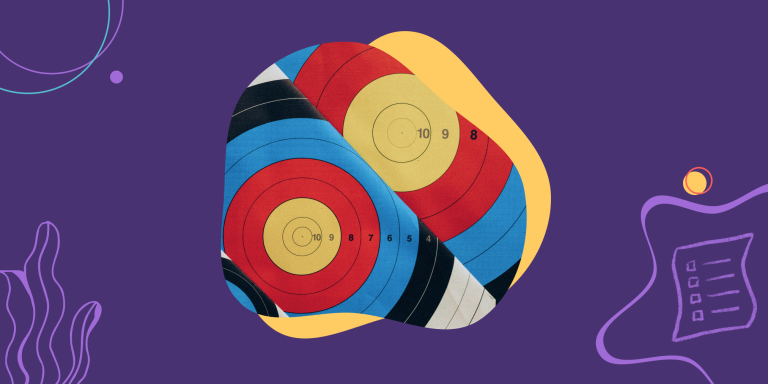9 Team Health Check Methods To Unlock Team Potential

When you haven’t been feeling well for a while, you call a doctor. Doctors check your vitals to analyze your health situation and propose a solution if necessary.
In the world of work, despite warning signs like productivity dips, decreasing job satisfaction, or even burnout, we often push forward, skipping the professional equivalent of a doctor’s visit: team health checks.
A lack of time or knowledge about team health checks prevents many teams from doing these assessments. But unlike doctors, you don’t need years of study to conduct a team health check. With an understanding of the team health metrics that matter and some practice, you can quickly assess team health factors like trust, psychological safety, and job satisfaction.
By the end of this article, you’ll know what these checks are and how to measure team health continuously with the right methods.
Here’s what we’ll cover:
What are team health checks?
Team health checks are structured reviews of a team’s performance and well-being. Similar to a medical check-up for your physical health, a team health check evaluates a group’s emotional well-being, interpersonal dynamics, work-life balance, and effectiveness.
These checks aim to find problems or difficulties that impact how a team works and performs. By measuring key metrics, such as happiness, morale, communication quality, trust, and psychological safety, these reviews help you understand how the group is doing so you can proactively make changes and prevent things like burnout or resignations.
Why team health checks are important?
A team health check acts as an early warning system to find problems before they escalate into crises.
Here are some of the benefits team health checks can bring:
- Improved performance. Regular health checks help identify problems early, allowing you to intervene quickly and improve or maintain performance.
- Enhanced communication. Health checks uncover areas of misunderstanding or miscommunication, making it easier to share information and collaborate.
- Increased trust. Trust metrics give an idea of how much trust team members have in each other. By dealing with trust issues, health checks encourage better teamwork.
- Higher employee retention. Health checks evaluate work-life balance, team dynamics, and psychological safety, all impacting job satisfaction and employee retention.
- Early conflict resolution. Regular assessments can detect simmering interpersonal issues or conflicts, allowing you to address them before they escalate.
- Better organizational alignment. Health checks involve reviewing team goals against business objectives, ensuring a team’s activities align with the broader strategy.
- More diversity and inclusion. Health checks can reveal and improve the level of diversity and inclusion within the team, helping to create a more respectful and innovative working environment.
When to run team health checks
Team health checks aren’t one-time events. It’s a good idea to conduct them regularly to keep the pulse of your work, to monitor changes, and for continuous improvement. Some teams conduct checks quarterly. Others prefer holding them monthly or even weekly at the beginning or end of meetings.
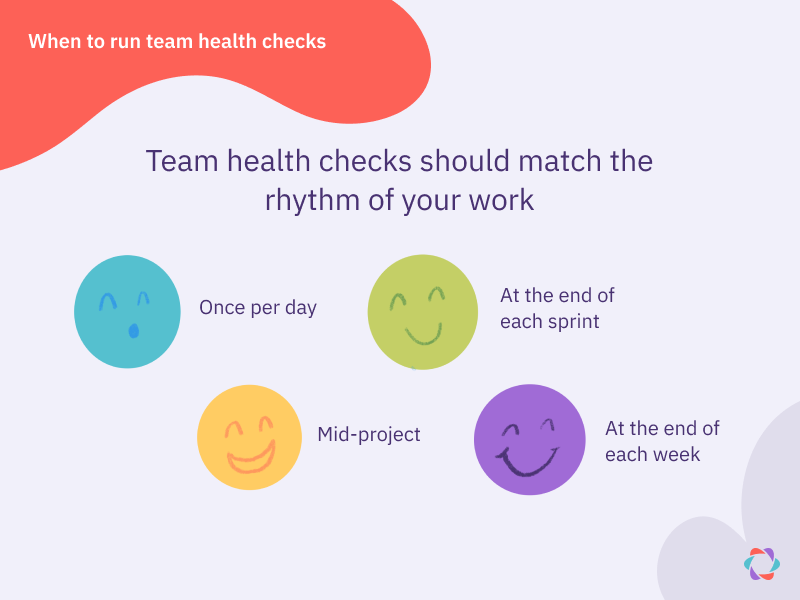
You should hold team health checks when they align with your team’s rhythm or significant changes in the group or project.
For example, Agile teams might do a health check at the end of each sprint, aligning it with their two-week or one-month work cycle, or even daily in the standup. A team working on a longer-term project with less frequent milestones might prefer a mid-project check in, or quarterly checks.
Changes in team or project dynamics that might trigger more frequent checks including:
- Shifts in team composition (like the arrival of new members)
- Changes in project scope
- The start of a new project phase
- A product launch
- Important client feedback
Regardless of frequency, the key is to maintain consistency in the timing of your health checks. A regular cadence allows you to track trends and progress over time, then act quickly on the insights you collect.
🙋♀️ How are team health checks different from retrospectives?
Team health checks look at the big picture of a team’s performance. They consider factors like happiness, trust, and communication to find opportunities for improvement.
Retrospectives are deep dives into a specific project or period. They might look at things that are similar to a team health check, but their main goal is improving the team’s work processes. They’re less about how the team feels and more about how the team works on a specific project.
Team health check methods and approaches
You need a systematic approach to get results and helpful insights from your team health checks. Several companies, including Spotify, Atlassian, and Google, have developed such methods. You can follow their lead or customize your own approach.
1. Parabol’s simple team health check
Parabol’s “team health” check is a self-assessment designed for agile teams. It can be run at the start of sprint retrospective, lessons learned, or project/incident post-mortem meetings.
It focuses on the team’s mood and well-being. Team members vote anonymously and results are revealed anonymously so nobody feels exposed.
Parabol’s team health check helps identify early signs of burnout by tracking mood metrics over time and summarizing team health scores.
For example, a downward trend in mood metrics over several weeks could prompt a deeper discussion about workloads, stress factors, or other potential issues. By closely monitoring these metrics, you can ensure a sustainable work pace, ultimately nurturing better teamwork and employee well-being.
Team health is voted on at the start of retrospectives, so you have the opportunity of your meeting afterwards to discuss any concerning results.
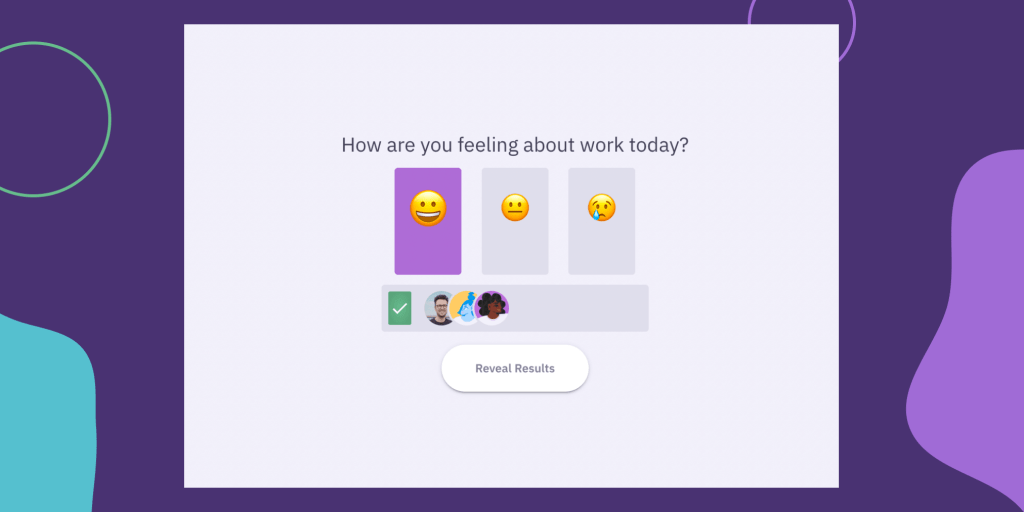
⭐ Key characteristics:
- Designed for agile teams, or teams running retrospectives, lessons learned, or post-mortem meetings
- Simple team health check that takes less than 30 seconds to complete
- Comes immediately before your meeting, giving you time to discuss results
🚦 Pros and cons:
- Pro: Simple and quick way to measure team health
- Pro: Voting and results are anonymous so people can be open and honest without feeling exposed
- Pro: Easy to set up and use with no preparation needed
- Con: Simple approach may not be advanced enough for teams that want to track multiple team health metrics
2. Spotify’s squad model team health check
Spotify’s “squad” health check is a self-assessment method where teams – called “squads” at Spotify – periodically evaluate their performance on tech, team, and product health.
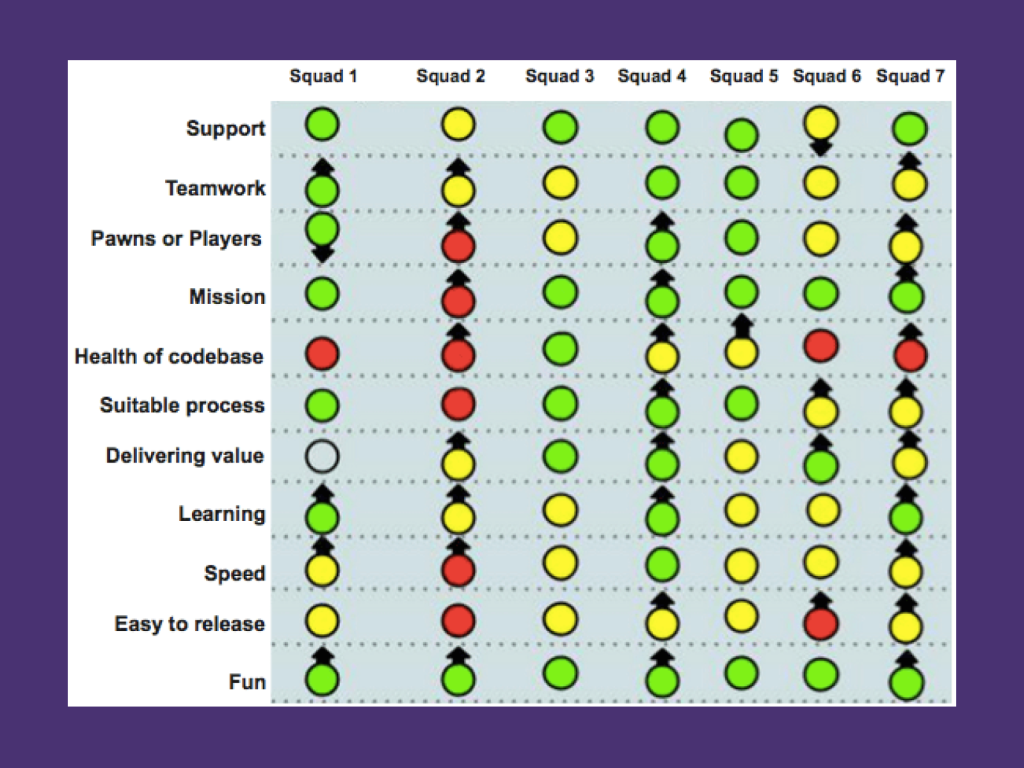
Each team member answers predefined questions, and their aggregated responses are visualized on a color-coded chart (also known as a Niko Niko calendar), providing an overview of the current state of teams and historical trends.
The visual chart is a great starting point for the team during debrief workshops, where they make decisions and action plans based on the exercise. The method also gives leadership insights into patterns and trends across multiple groups.
⭐ Key characteristics:
- Designed for cross-functional teams
- Asks predefined questions about technical, team, and product health
- Involves debrief workshops for discussing survey results and creating action plans
- Aggregates results for a multi-team-level visualization of patterns and trends
🚦 Pros and cons:
- Pro: Encourages self-assessment, which empowers teams and creates a sense of ownership
- Pro: Reveals systemic improvement areas over a longer period than regular retrospectives
- Con: May not be as effective in non-cross-functional teams or larger teams
- Con: Requires manual aggregation and documentation in visual chart
- Con: Hard to ensure visibility of chart among squads and at higher levels in the org
💡 Read more about the Spotify “squad” team health check in Getting More from Your Team Health Checks (Spotify).
3. Atlassian’s Team Health Monitor
The Atlassian health check, also known as the Team Health Monitor, is a comprehensive team self-assessment tool. It looks at eight key attributes of team health, including shared understanding, continuous improvement, and customer focus. The assessment allows teams to recognize their strengths, face their weaknesses, and identify areas for growth.
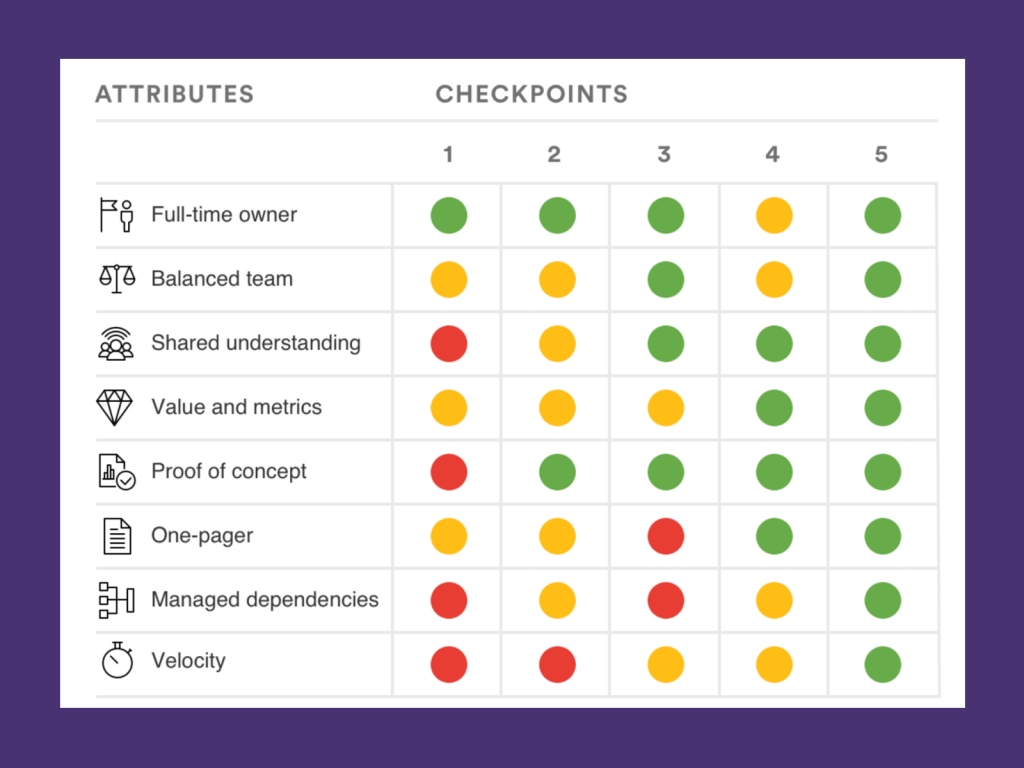
The Atlassian team health monitor lets team members assess themselves against these eight attributes, resulting in a Health Monitor Grid (pictured below). This visual representation gives teams an understanding of their performance across these critical areas and an opportunity to make data-driven decisions for improvement.
The Health Monitor includes a series of checkpoints where teams get together and make an evaluation according to the various indicators.
⭐ Key characteristics:
- Comprehensive and wide-ranging, covering eight key attributes from decision-making to customer focus
- Produces a visual output (Health Monitor Grid) for easy understanding and analysis
- Designed for different types of teams, such as project, leadership, and service
🚦 Pros and cons:
- Pro: Provides a broad view of team health
- Pro: Allows teams to recognize strengths and weaknesses across multiple areas
- Pro: Helps teams visualize performance and make data-driven decisions
- Con: Could be time-consuming to execute due to its comprehensive nature
💡 Read more about the Atlassian health check approach in Team Health Monitors and Why Your Startup Needs a Check-up (First Round Review).
4. Agile team health check
An Agile team health check helps teams identify the strengths and weaknesses in their Agile practices. These checks typically focus on a team’s understanding and execution of Agile values and principles and specific practices like continuous integration (integrating an individual developer’s changes with the project multiple times a day to prevent integration problems), maintaining a sustainable pace, and effective communication for coordination and problem-solving.
You can conduct an Agile health check using dedicated tools, custom-designed questionnaires, or methodologies that align with your team’s specific needs and context.
These assessments help map your team’s progress and growth within the Agile framework. You can hold checks regularly, such as during sprint retrospectives or at the end of project milestones.
⭐ Key characteristics:
- Custom designed for Agile teams and covers Agile-specific topics
- Involves guided self-assessment, often with the support of an Agile coach as the facilitator
🚦 Pros and cons:
- Pro: Helps Agile teams maintain their Agile mindset and practices
- Pro: Provides structured feedback and a roadmap for continuous improvement
- Con: May not be applicable or as effective for non-Agile teams
- Con: Often requires trained facilitators with a deep knowledge of specific agile frameworks for best results
5. Team health radar
The team health radar visualizes team health across multiple dimensions, such as clarity, performance, leadership, culture, and foundation. It presents metrics in a radar chart, so you can quickly see if there are unusual results or where you can improve.
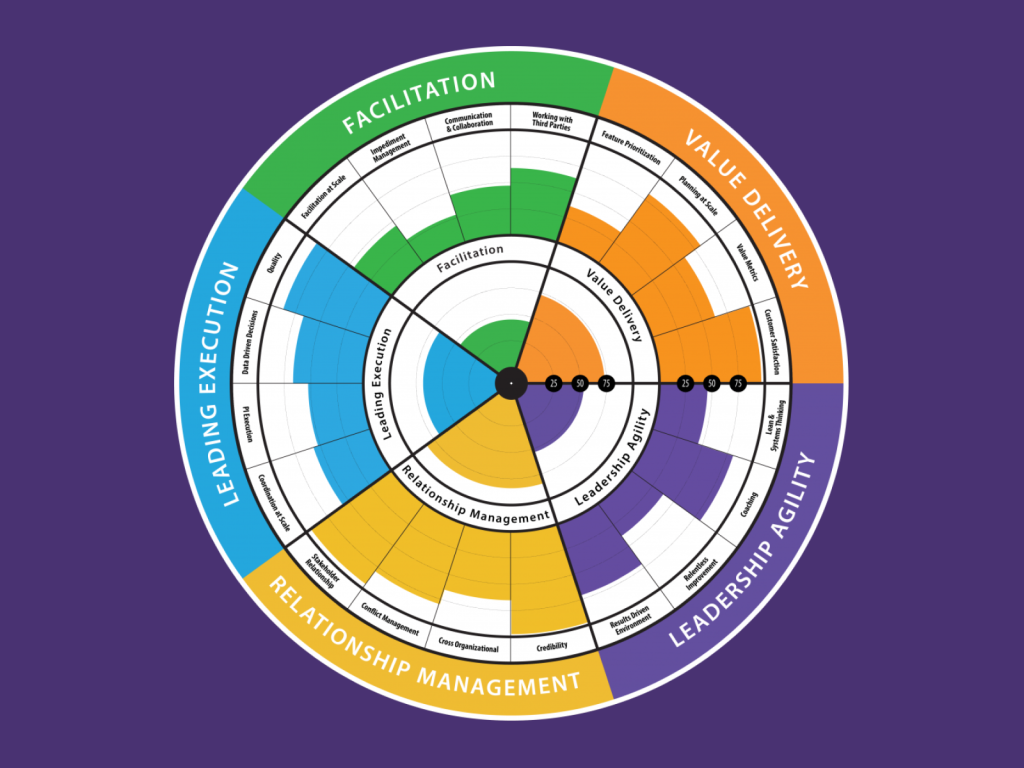
You typically use the radar during a dedicated retrospective led by a certified AgilityHealth Facilitator. These sessions have two stages: an assessment review and a growth planning discussion.
The assessment review involves evaluating team maturity and performance. The growth planning discussion focuses on identifying patterns and creating improvement plans for both teams and their leaders.
⭐ Key characteristics:
- Visual representation of metrics
- Ideal for tracking progress over time
- Measures across multiple dimensions, including clarity, performance, leadership, culture, and foundation
- Conducted by agile team members, often facilitated by certified AgilityHealth professionals
🚦 Pros and cons:
- Pro: Allows for easy identification of outliers and areas for improvement
- Pro: Provides a comprehensive view of team health
- Con: May lack nuanced information or the context behind specific scores
- Con: Requires trained facilitators for effective implementation
- Con: Can be confusing to read
- Con: Difficult to effectively track trends over time
💡 Read more about the Team Health Radar over at AgilityHealth.
6. Niko-Niko calendar
The Niko-Niko calendar lets team members record their moods at the end of each workday. These entries, often represented by hand-drawn “emoticons” or colored stickers, provide insights into the team’s emotional well-being over time. Both the Atlassian Health Monitor and Spotify squad model use a Niko Niko calendar approach to tracking team health.
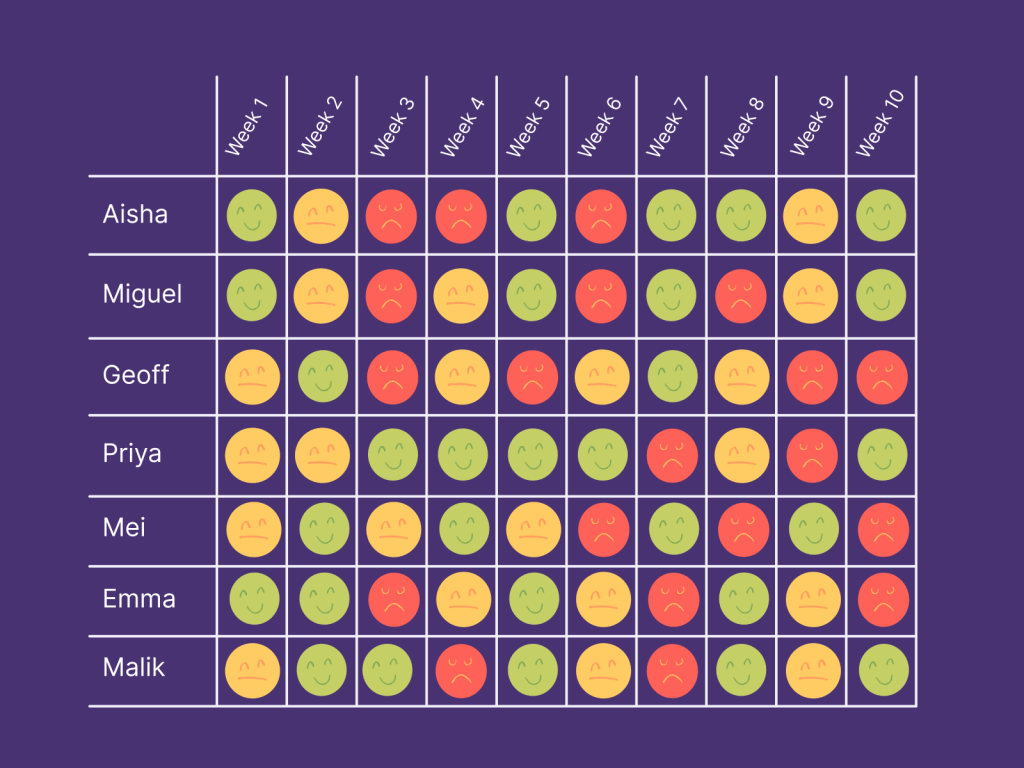
By revealing patterns of mood changes, the Niko-Niko calendar serves as a visual representation of the team’s emotional climate. This insight can help you identify events or activities that trigger certain moods, spark discussions in team meetings or retrospectives, and serve as an early warning system for potential issues.
It is up to the team and its leaders to analyze the information and decide how to address any emerging issues or trends. If available, you can involve an Agile coach or other facilitator to help guide discussions and develop action plans based on the Niko-Niko calendar data.
⭐ Key characteristics:
- Focuses on emotional well-being
- Tracks moods daily
- Uses visual symbols or colors to record daily moods
🚦 Pros and cons:
- Pro: Provides insights into the team’s emotional health and reveals mood patterns over time
- Pro: Encourages team members to share their feelings, encouraging transparency and trust
- Con: May not provide deep insights into other aspects of team health beyond its emotional state
- Con: Relies on honest self-reporting, which can be influenced by the team culture
- Con: Teams define their uses for the data from the calendar because there is no official “Niko-Niko” approach
- Con: Depending on how you use it, can make people feel vulnerable or result in false reporting if people can see your individual score
Honorable mentions: Other team health checks
The methodologies above are widely recognized and used, but many other team health check approaches exist. These tools offer valuable insights into specific needs and situations.
Google’s re:Work check zeroes in on team effectiveness. It measures things like psychological safety, dependability, clear roles, and work’s meaning – all found to be critical factors in successful teams by Google’s own research.
The Gallup Q12 is a survey that measures employee engagement. Its 12 questions cover different work-life aspects – from job clarity and available resources to teamwork, recognition, and growth opportunities. It’s used across industries and gives a rounded view of team health.
A Leadership Health Check assesses leadership effectiveness within a team or organization. It covers communication, decision-making, strategic direction, and employee development. This check can help identify areas where your leadership is strong or could use some work.
Bonus: DIY team health check
A DIY (Do-It-Yourself) team health check lets you tailor an approach to your team’s needs – you pick the metrics and questions that matter most to your group and organization. The DIY approach requires understanding what to measure and how but offers the most flexibility. For inspiration on what to measure in your DIY health check, see this article on team health metrics and indicators.
Team health check questions
Health checks can come in different forms, from surveys and formal sessions to quick check-ins at the start of a meeting. But no matter the format, a good question forms the basis of any effective health check.
Thoughtful questions assess the present situation, inspire reflection, and encourage conversation among team members.
Here are 16 team health check questions and statements to help you check the health of your team. You can use these as a starting point to create questionnaires, customize your approach, or gauge individual or team sentiments:
- How happy are you with your team’s collaboration and joint efforts this week? (1-5 scale)
- How happy are you with your role in the company? (1-5 scale)
- How would you rate the fun factor in your work this week? (1-5 scale)
- How would you rate your ability to focus this week? (1-5 scale)
- How would you describe your mood today?
- In my team, I feel fit and strong. (1-5 scale)
- I am proud of the work that I do for my team. (1-5 scale)
- I am enthusiastic about the work that I do for my team. (1-5 scale)
- The work I do for my team has meaning and purpose. (1-5 scale)
- What is the most satisfying aspect of your work currently?
- What is the most challenging part of your work currently?
- What changes would you suggest to improve your work experience?
- Did we plan adequately for our tasks this week?
- How do your tasks align with your professional growth goals?
- Which behaviors support you in your role and which do not?
- What would be needed for you to score higher on your happiness or satisfaction at work?
What to do with the results of your team health checks
Like any good treatment plan, the real work begins after the diagnosis. The health check’s value lies not just in identifying problems but in using that knowledge to improve.
Here are some actions you can take based on the outcomes of your health checks:
- Debrief: Hold a debrief with your team after conducting a team health check. Encourage members to openly discuss their concerns, ideas, and suggestions for improvement, building trust, transparency, and psychological safety.
- Establish goals and action plans: Create specific, measurable, achievable, relevant, and time-bound goals to improve the identified problem areas.
- Adjust team processes: If the health check outcomes suggest problems with how you work, consider revising processes, workflows, or communication methods to support team collaboration and performance.
- Provide training and support: When you identify skill or knowledge gaps, respond by providing the necessary training, coaching, or mentoring.
- Visualize outcomes: Create a graphical summary of the results. This visual snapshot gives a high-level view of the team’s health, can highlight patterns not apparent in raw data, and act as a point of reference later.
Remember, in the end, your goal is to have a healthy team and maintain that health over time. Plan for regular checks and follow-up actions to ensure your team’s well-being continuously improves.

